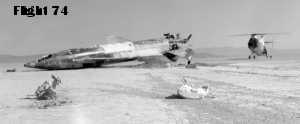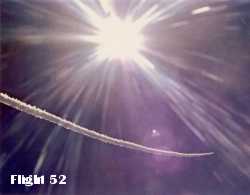

| Flight
1 (1-1-5) |
June
8, 1959 |
X-15's
first flight ends with a challenging landing |
| Flight 51 (3-4-8) | April 20, 1962 | Neil Armstrong's reentry skip |
The X-15 Adventures section is in its infancy, it will grow slowly. Follow this link to see candidates for future additions at the end of this web page.
Every X-15 flight was an adventure, a high-speed dash that often pushed into unexplored realms of flight. Flights frequently set new records in speed and altitude, as well as records in less-known measurements such as airframe heating and dynamic pressure. With the XLR-99 rocket engine operating at full throttle pilots experienced a minimum of 2 g's acceleration, building to over 4 g's as fuel burned off. Pilot Milt Thompson commented that this was the only aircraft he'd flown that made him glad when the engine quit. Even then, with power off, the X-15 dropped about 9,000 feet per minute in a glide.
Some X-15 flights proved to be high adventure. The X-15 itself was a very novel and complex system that operated in space as well as in the air. It pushed beyond known territory in hypersonic stability and control, and it explored reentry into the atmosphere from space. It was an experimental exercise in new technology, and risks were always present. Components could fail, systems could fail, and parts of the design could reveal what wasn't previously known. Most flights ended safely, but the program did claim the life of one test pilot, Mike Adams, and seriously injured another, John McKay. The adventures decribed here involve everything from mishaps to historic milestones achieved on flawless flights.
This section is intended to present many of the X-15 program's adventures stories, not only because they tend to be great stories but also to give a sense of the scope and the reality of X-15 flight research. Some stories will include material from NASA's flight logs, such as postflight reports and radio communication transcripts. These provide insight into the discipline of test flying, indications of the extensive preflight planning and postflight analysis that were part of the research program, and the scope of support needed for the program. Test pilots receive most of the attention because they were the ones directly involved in the X-15 cockpit, but their success and that of the research program as a whole belonged to a large group of people.
Candidates
for additional adventure stories to add...
those in boldface are linkely
to be added first.
|
|
|
|
| (several) | early 1959 | Initial captive carries and aborts |
| 2 (2-1-3) | September 17, 1959 | Scott Crossfield lands after turbopump failure & fire |
| 3 (2-2-6) | October 17, 1959 | Crossfield has fire in engine bay, gear door failure |
| 4 (2-3-9) | November 5, 1959 | Engine fire and explosion, fuselage failure on landing |
| 14 (1-6-11) | May 6, 1960 | Bob White has trouble shedding the ventral |
| 15 (1-7-12) | May 12, 1960 | Joe Walker passes Mach 3 |
| 16 (1-8-13) | May 19, 1960 | Bob White passes 100,000 feet |
| Ground test | June 8, 1960 | Scott Crossfield rides as #3 explodes |
| 22 (1-13-25) | September 23, 1960 | Engines fail for Forrest Petersen |
| 26 (2-10-21) | November 15, 1960 | First flight with the XLR-99 |
| 34 (2-13-26) | March 7, 1961 | Bob White breaks Mach 4 |
| 35 (2-14-28) | March 30, 1961 | Joe Walker breaks altitude record after a relight |
| 36 (2-15-29) | April 21, 1961 | Bob White handles 3 hardware problems |
| 38 (2-17-33) | June 23, 1961 | Bob White passes Mach 5 |
| 43 (2-20-36) | October 11, 1961 | Bob White breaks 200,000 feet and left windshield |
| 45 (2-21-37) | November 9, 1961 | Bob White breaks Mach 6 and right windshield |
| 47 (1-25-44) | January 10, 1962 | Forrest Peterson's emergency landing at Mud |
| 52 (1-27-48) | April 30, 1962 | Joe Walker 's altitude record nudges 250,000 feet |
| 53 (2-22-40) | May 8, 1962 | Bob Rushworth passes 2,000 psf dynamic pressure |
| 59 (1-30-51) | June 27, 1962 | Joe Walker breaks speed record at 4,105 mph |
| 61 (1-31-52) | July 16, 1962 | Joe Walker deals with trip-outs |
| 62 (3-7-14) | July 17, 1962 | Bob White passes 50 miles, earns astronaut wings |
| 67 (3-9-18) | August 14, 1962 | Lack of roll damper gives Walker a wild ride |
| 71 (3-10-19) | October 4, 1962 | Rushworth loses APU, ball nose, and yaw damper |
| 74 (2-31-52) | November 9, 1962 | John McKay crash-lands on Mud Dry Lake |
| 77 (3-14-24) | January 17, 1963 | Walker earns astronaut wings despite system troubles |
| 79 (3-15-25) | April 18, 1963 | Nose gear scoop door opens at Mach 3.4 |
| 83 (1-35-56) | May 15, 1963 | McKay has gear scoop door open at Mach 5.2 |
| 87 (3-20-31) | June 27, 1963 | Bob Rushworth qualifies as astronaut |
| 90 (3-21-32) | July 19, 1963 | Walker takes experiments to 347,800 feet |
| 91 (3-22-36) | August 22, 1963 | Joe Walker hits 354,200 feet on his last flight |
| 93 (1-40-64) | October 29, 1963 | Milt Thompson's first flight (this may be only a reference to Thompson's excellent description of this flight in his book) |
| 97 (1-42-67) | December 5, 1963 | Bob Rushworth hits Mach 6.06 |
| 98 (1-43-69) | January 8, 1964 | Joe Engle handles inertial instruments failure |
| 100 (1-44-70) | January 28, 1964 | Bob Rushworth flies 100'th flight of program |
| 106 (3-28-47) | May 12, 1964 | John McKay handles problems with inertials & SAS |
| 108 (3-29-48) | May 21, 1964 | Milt Thompson lands at Cuddeback |
| 111 (3-30-50) | July 8, 1964 | Joe Engle handles damper & MH-96 trouble |
| 114 (2-33-56) | August 14, 1964 | Rushworth's nose gear deploys at Mach 4.2 |
| 118 (2-34-57) | September 29, 1964 | Nose gear scoop door causes handling touble |
| 125 (3-39-62) | January 13, 1965 | Thompson recovers from control ploblems |
| 127 (2-36-63) | February 17, 1965 | Rushworth handles Mach 4.3 skid extension & more |
| 138 (3-44-67) | June 29, 1965 | Joe Engle hits 280,600 feet, qualifies as astronaut |
| 152 (3-50-74) | October 12, 1965 | Pete Knight has APU shutdown and more |
| 155 (2-43-75) | November 3, 1965 | First X-15A-2 flight with external tanks |
| 156 (1-62-103) | November 4, 1965 | Bill Dana needs 2 relights on his first flight |
| 157 (1-63-104) | May 6, 1966 | Pump forces McKay to land at Delamar |
| 159 (2-45-81) | July 1, 1966 | Faulty signal forces Rushworth to land at Mud |
| 166 (1-66-111) | August 11, 1966 | John McKay reaches record high dynamic pressure |
| 169 (1-67-112) | August 25, 1966 | McKay has inertial malfunction on reentry |
| 170 (2-49-86) | August 30, 1966 | Pete Knight has SAS dropouts, H2O2 fire in ventral |
| 171 (1-68-113) | September 8, 1966 | McKay's last landing is forced to Smith Ranch |
| 173 (1-69-116) | October 6, 1966 | Mike Adams forced to land at Cuddeback |
| 174 (3-56-83) | November 1, 1966 | Bill Dana makes last X-15 flight over 300,000 feet |
| 177 (1-70-119) | March 22, 1967 | Adams handles glitches without cockpit pressure |
| 178 (3-58-87) | April 26, 1967 | Bill Dana lands at Silver Lake |
| 180 (2-51-92) | May 8, 1967 | Knight deals with new eyelid & window fogging |
| 181 (3-59-89) | May 17, 1967 | Bill Dana copes with severe tail oscillations |
| 183 (3-60-90) | June 22, 1967 | Bill Dana's second bout with severe tail oscillations |
| 184 (1-73-126) | June 29, 1967 | Pete Knight loses both APU's and all power |
| 186 (2-52-96) | August 21, 1967 | Trials of full ablative coating |
| 188 (2-53-97) | October 3, 1967 | Pete Knight nearly incinerates tail at Mach 6.7 |
| 190 (3-64-95) | October 17, 1967 | Pete Knight joins astronauts at 280,500 feet |
| 191 (3-65-97) | November 15, 1967 | Inflight breakup of #3 kills Mike Adams |
| 197 (1-79-139) | August 21, 1968 | X-15's last flight above 50 miles |
| 199 (1-81-141) | October 24, 1968 | Last flight of the X-15 program |